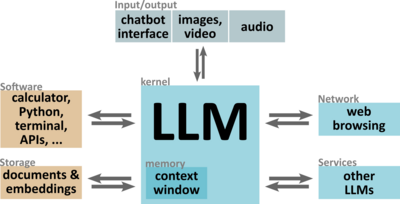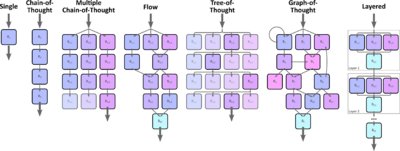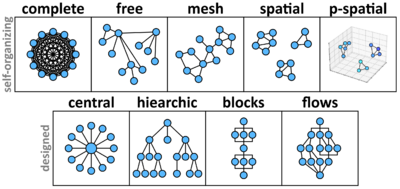Difference between revisions of "ERI"
KevinYager (talk | contribs) (→Models) |
KevinYager (talk | contribs) (→Models) |
||
| Line 25: | Line 25: | ||
#*** 2025-02: [https://arxiv.org/abs/2502.03714 Universal Sparse Autoencoders: Interpretable Cross-Model Concept Alignment] | #*** 2025-02: [https://arxiv.org/abs/2502.03714 Universal Sparse Autoencoders: Interpretable Cross-Model Concept Alignment] | ||
| − | '''Challenge: Connect reasoning models to domain models | + | '''Challenge: Connect reasoning models to domain models''' |
# Latent space reasoning | # Latent space reasoning | ||
# Establish mappings (analogies) between interpretability spaces | # Establish mappings (analogies) between interpretability spaces | ||
| + | #* 2024-12: [https://arxiv.org/abs/2412.16325 Towards Safe and Honest AI Agents with Neural Self-Other Overlap] | ||
| + | #** 2024-07: [https://www.lesswrong.com/posts/hzt9gHpNwA2oHtwKX/self-other-overlap-a-neglected-approach-to-ai-alignment Self-Other Overlap: A Neglected Approach to AI Alignment] | ||
| + | #** 2025-03: [https://www.lesswrong.com/posts/jtqcsARGtmgogdcLT/reducing-llm-deception-at-scale-with-self-other-overlap-fine Reducing LLM deception at scale with self-other overlap fine-tuning] | ||
# Cycling recaptioning/reframing | # Cycling recaptioning/reframing | ||
#* 2024-07: [https://arxiv.org/abs/2407.06723 Graph-Based Captioning: Enhancing Visual Descriptions by Interconnecting Region Captions] | #* 2024-07: [https://arxiv.org/abs/2407.06723 Graph-Based Captioning: Enhancing Visual Descriptions by Interconnecting Region Captions] | ||
Revision as of 11:43, 16 March 2025
ERI
Contents
Research Thrusts
Models
How to adapt frontier methods and foundation models to science?
- Topical fine-tuning
- Tool-use
- Advanced retrieval-augmented generation (RAG++)
- Novel: Pre-generation: Agents continually add content to RAG corpus. ("Pre-thinking" across many vectors.)
- Science-adapted tokenization/embedding (xVal, [IDK])
- Specialized sampling
- Entropy sampling: measure uncertainty of CoT trajectories
- Novel: Handoff sampling:
- Useful for:
- text-to-text (specialization, creativity, etc.)
- text-to-tool (e.g. math)
- test-to-field (integrate non-textual FM)
- Implementation:
- MI-SAE on both spaces, find matches (or maybe just "analogies"?)
- GNN, e.g.: 2019-11: SuperGlue: Learning Feature Matching with Graph Neural Networks (hf)
- 2025-02: Universal Sparse Autoencoders: Interpretable Cross-Model Concept Alignment
- Useful for:
Challenge: Connect reasoning models to domain models
- Latent space reasoning
- Establish mappings (analogies) between interpretability spaces
- Cycling recaptioning/reframing
- Tokenizer-for-science: learn right spectrum of representations (for text/image reasoning model)
Agents
How to make AI agents smarter?
- Iteration schemes (loops, blocks)
- Thinking:
- Blocky/neural: Define architecture, allow system to pick hyper-parameters
- Autonomous ideation:
- Novel: Treat ideation as an AE problem in a semantic embedding space.
- Dynamic tree-of-thought: on-demand context generation, allows model to select among data representations (zoom, modality, etc.)
- Thinking:
- Encode Human Patterns
- Human scientist workflows (ideation, solving, etc.)
- Thought-templates, thought-flows
- How to allow agents to run for long time-horizons coherently?
- Basket of Metrics: Need to define metrics of: (1) research success, (2) uncertainty (entropy sampling?)
- Tool-use to "call human" and request help/information
- Memory
- Allow system to insert and retrieve from RAG at will.
Exocortex
What is the right architecture for AI swarms?
- Interaction schemes
- Test options, identify match between science task and scheme
- Treat interaction graph as ML optimization problem
- Novel: Map-spatial: Use a map (e.g. of BNL) to localize docs/resources/etc.
- Novel: Pseudo-spatial: Use position in embedding space to localize everything. Evolving state (velocity/momentum) of agent carries information.
- Novel: Dynamic-pseudo-spatial: Allow the space to be learned and updated; directions in embedding space can dictate information flow
- Establish benchmarks/challenges/validations
Infrastructure
Architecture
What software architecture is needed?
- Code for scaffolding
- Scheme for inter-agent messaging (plain English w/ pointers, etc.)
- Data management
Hardware
How to implement inference-time compute for exocortex?
- Heterogeneous hardware
- Elastic (combine local & cloud)
- Workflow management
Human-Computer Interaction (HCI)
What should the HCI be?
Resources
- Need models, data, facilities, etc. all accessible as API endpoints.


